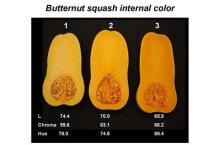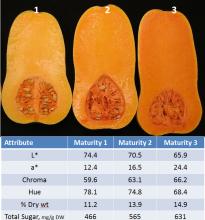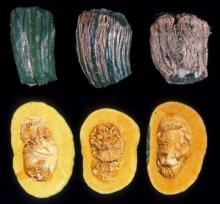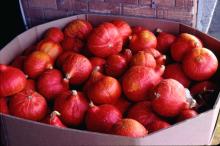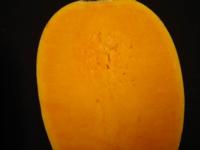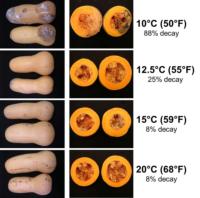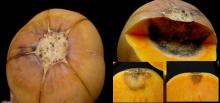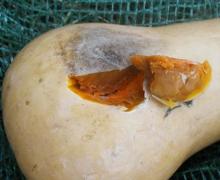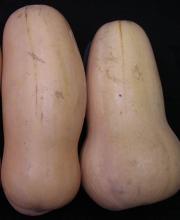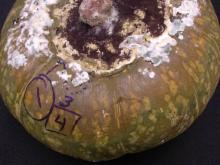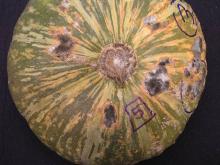Indices de Maturité
Corking of the stem and subtle changes in rind color (bright green to dull green in ‘Kabocha’ for example, Photo 1, Photo 2) are the main external indications of maturity. Immature fruit have a fleshy stem, maturing fruit will have some stem corking, and well mature fruit will have a well corked stem. In winter squash, such as butternut, external color changes only slightly during maturation (Photo 3). Internal color should be intense and typical of the cultivar (Photo 4). The concentrations of the yellow and orange carotenoids generally increase only slightly during storage. Maturity at harvest is the major determinant of internal color. Immature fruit will be of inferior eating quality because they contain less stored carbohydrates (Photo 4). Immature fruit will have more decay and weight loss during storage than mature fruits.
Pumpkin and winter squash should be full sized and well formed with the stem intact. They should be well matured with good rind development typical of the cultivar. Internal quality attributes are high color due to a high carotenoid content, and high dry weight and sugar and starch contents (Photo 4).
Manipulation et stockage post-récolte
12.5-15°C (55-59°F)
Pumpkins and winter squash are very chilling sensitive when stored below 10°C (50°F). Depending on the cultivar a storage life of 2 to 6 months can be expected at 12.5-15°C (55-59°F). Research at Oregon State University showed that for 8 currently produced winter squash cultivars stored at 10-15°C (50-59°F), 90%, 70% and 50% were marketable after 9, 15 and 20 weeks, respectively. For green rind squashes, storing at 15°C (59°F) may cause degreening, undesirable yellowing, and texture loss. The green rind squashes can be stored at 10-12°C (50-55°F) to prevent degreening, although some chilling injury may occur at the lower temperature. High storage temperature (>15°C) will result in excessive weight loss, color loss and poor eating quality. In a UC Davis study, the best temperature for butternut squash storage for 7 months was 15°C (59°F) (Photo 5). Besides weight loss and browning and drying of damage areas, higher storage temperatures also lead to more rapid breakdown of pulp tissue (Photo 6).
30-60 ml CO2/kg·hr at 25°C (77°F)
To calculate heat production, multiply ml CO2/kg·hr by 440 to get BTU/ton/day or by 122 to get kcal/metric ton/day.
Exposure to ethylene will degreen squash with green rinds. Ethylene will also cause abscission of the stem, especially in less mature fruit.
50-70% with 60% usually considered optimum moderate relative humidity with good ventilation is essential for optimum storage. High humidity will promote decay. Although 50-70% R.H. will reduce decay during storage, significant weight loss will occur. For example, mature Kabocha squash lose 1.0 and 1.5% of their fresh weight per week of storage at 12.5°C (59°F) and 20°C (68°F), respectively. Weight loss of butternut squash stored at 12.5°C and 20°C was 2.5% and 5.5% per month, respectively.
2H4/kg·hr at 20°C
If the pumpkin or winter squash are chilled, ethylene production rates can be 3-5 times higher.
Atmospheres containing 7% CO2 can be beneficial by reducing loss of green color. Yellow squash, however, appear not to be benefited by 5 or 10% CO2 atmospheres. Lowering the O2 concentration does not appear to provide any benefit. Univ. of Georgia research showed that storing different pumpkin cultivars at 10°C (50°F) for 2-3 months in 3% O2 + 5% CO2 increased the percent of marketable fruit compared to pumpkins held at ambient conditions.
Temperature & Controlled Atmosphere Photos
Désordres
Chilling injury. Caused if pumpkins and squashes are stored below 10-12.5°C (50-55°F). Symptoms of chilling injury are sunken pits on the surface and high levels of decay once fruit are removed from storage. Storing fruit 1 month at 5°C (41°F) is sufficient to cause chilling injury symptoms. Depending on the cultivar, storage for several months at 10°C (50°F) may cause some chilling injury (Photo 5). Changes in respiration rates will precede visible chilling injury symptoms (Photo 6).
Freezing injury. Can occur at temperatures below -0.8°C (30.5°F).
Several fungi are associated with decay during storage of pumpkins and winter squashes (See Disorder Photos). Fusarium, Pythium and anthracnose (Colletotrichum) and gummy stem blight or black rot (Didymella) (Photo 7, Photo 8) are common fungi. Alternaria rot (Photo 9) will develop on chill-damaged winter squashes. Fruit that are overmature at harvest (>2 weeks beyond optimal harvest date) will tend to have more storage decay. Rhizopus may develop rapidly on fruit that have been injured at harvest (Photo 10).
Special Considerations
Curing. The fruits may have tender rinds when freshly harvested. Curing in the field, with protection from the sun (Photo 13) by placing under the leaves, before handling and stacking into bins or wagons will help to harden or cure the rind. The recommended storage conditions also favor curing or hardening of the rind.



